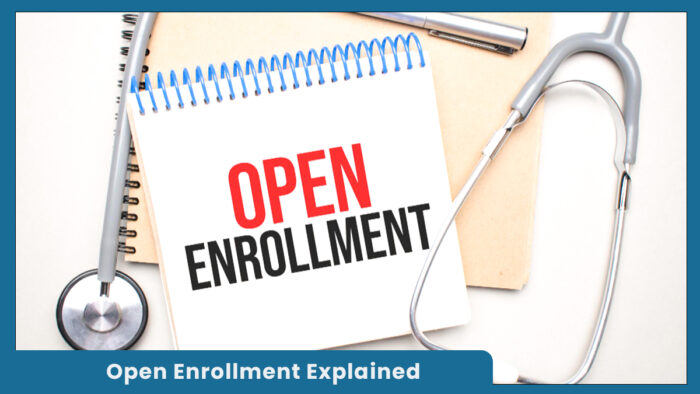Open Enrollment Explained – Open enrollment is the time each year when you can sign up for a new health insurance plan or make changes to your current one. This period applies to health plans from the ACA Marketplace, your employer, or Medicare. Insurance companies limit enrollment to specific times of the year to prevent people from signing up only when they are sick. This helps keep insurance affordable and fair for everyone.

During open enrollment, you can enroll in a new plan, switch to a different one, or cancel your current coverage. If you miss this window, you may have to wait until the next open enrollment unless you qualify for a special enrollment period. Special enrollment is available if you experience certain life events like marriage, the birth of a child, or the loss of other health coverage.
Any changes you make during this period usually take effect in the following year. This is a good opportunity to review your current coverage, compare your options, and make sure your plan fits your needs.
What Types of Insurance Use Open Enrollment?
The open enrollment period for ACA Marketplace plans usually runs from November 1 to January 15. For Medicare, it starts on October 15 and ends on December 7. Employer-provided plans may have different dates, but they typically take place in the fall.
Open enrollment periods apply to several types of insurance, including Affordable Care Act (ACA) plans, employer-sponsored healthcare, and Medicare. Here is how each one works:
ACA Health Insurance
ACA health plans are available through Healthcare.gov for 32 states, while 18 states operate their own health insurance marketplaces. Some of these states may have slightly different enrollment periods or rules, but the differences are usually just by a few weeks.
Employer Health Insurance
If you get your health insurance through your job, your employer will likely offer a specific open enrollment window each year. During this time, you can enroll in or make changes to your health, dental, and vision plans. Many employers also let you add life insurance during this period.
Most employer open enrollment periods happen in the fall and last two to four weeks. This gives the company enough time to process your choices before the new coverage year begins on January 1.
Medicare
Medicare has its own open enrollment period, which allows you to change your medical or prescription drug plans. It is a good time to review your coverage because Medicare Advantage plans can change each year. You may find another plan that fits your needs or budget better.
There is also a separate Medicare Advantage open enrollment period. If you already have a Medicare Advantage plan, this window lets you switch to a different Advantage plan, choose a new drug plan, or return to Original Medicare.
What Types of Insurance Do Not Use Open Enrollment?
Some insurance programs allow you to apply at any time of the year. This includes:
Medicaid and CHIP
Medicaid and the Children’s Health Insurance Program (CHIP) accept applications year-round. You can apply through the Marketplace or your state’s Medicaid office.
These programs offer free or low-cost health coverage for eligible low-income adults and children. Whether you qualify depends on your income, family size, and whether your state has expanded Medicaid. The best way to find out if you are eligible is to fill out an application.
Can I Make Changes Outside Open Enrollment?
In most cases, you cannot make changes outside the open enrollment period unless you experience a qualifying life event. These events include things like getting married, having a baby, losing other health coverage, or moving to a new area.
You can cancel your Marketplace plan or remove someone from your coverage at any time. However, you cannot enroll in a new plan unless you qualify for special enrollment or wait until the next period. For employer-provided plans, you also have to wait for the next open enrollment unless you qualify for a special enrollment due to a major life change.
What If I Miss the Open Enrollment Period?
If you miss open enrollment, check if you are eligible for a special enrollment period. This applies to ACA plans, Medicare, and employer-based coverage. You can also apply for Medicaid or CHIP at any time if you qualify. If none of these options work for you, consider a temporary health plan.
Short-Term Health Plans
Short-term health insurance is a temporary option that can help cover basic medical needs. These plans usually start quickly and do not require you to stay within a provider network.
However, they are not available in every state and often do not meet ACA standards. Most short-term plans exclude pre-existing conditions and essential health benefits. They may also have a maximum coverage limit, meaning you could be responsible for any costs beyond that limit.
How to Prepare for Open Enrollment
Getting ready for open enrollment starts with reviewing your current health insurance plan and comparing it with your expected medical needs. This helps you identify any coverage gaps and find ways to reduce your premiums and out-of-pocket costs.
Even though you cannot predict every future health issue, you may already know about scheduled treatments, long-term medications, or health concerns that could lead to a diagnosis. These should all be considered as you prepare.
Preparing for Health Insurance Marketplace Open Enrollment
To get started with the Health Insurance Marketplace:
- Estimate your income and list who will be covered in the coming year.
- Check if you qualify for financial assistance like cost-sharing reductions or government health programs.
- Once enrollment begins, visit the federal or state website to compare plans. You can often search by doctors and medications to see which plans meet your needs and how much they may cost.
Preparing for Employer-Based Health Insurance Enrollment
If you get your health coverage through your job:
- Make sure your personal contact details are up to date with the HR department.
- A few weeks before open enrollment begins, your employer will usually send out benefit information. Review all documents including plan summaries, rate sheets, and key dates.
- If you have questions, contact HR. Some companies may offer info sessions or Q&A meetings to help you understand your choices.
Preparing for Medicare Open Enrollment
If you’re enrolled in Medicare, in September, you should receive a letter called the Annual Notice of Change (ANOC), which explains any changes to your current plan’s coverage and cost for the next year. If you don’t get it, call your plan provider. Review your options by visiting the official Medicare website.
Frequently Asked Questions (FAQs)
How long does open enrollment last?
The length of the open enrollment period depends on the type of health plan:
- Marketplace plans through Healthcare.gov usually have a window of nearly three months.
- Medicare open enrollment runs for about two months.
- Medicare Advantage has an annual window that lasts around three months.
- Employer plans typically offer two to four weeks for open enrollment.
What is a qualifying life event?
A qualifying life event is a major change in your life that allows you to get or change health coverage outside of open enrollment. Common examples include:
- Losing your current health insurance or Medicaid eligibility
- Getting married, divorced, having a child, or adopting
- Moving to a new area or ZIP code
- Gaining citizenship or experiencing an income shift that changes your eligibility
- Other rare situations like natural disasters or incorrect plan information
The Bottom Line
Open enrollment is your main chance each year to sign up for or change your health insurance plan. If you miss it and do not have a qualifying life event, you may have to wait until the next period.
In the meantime, short-term health plans or healthcare-sharing programs can offer some support. If you qualify, Medicaid and CHIP are always open for enrollment and may be a good solution.



